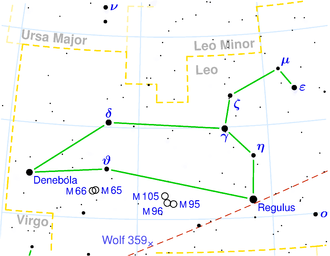NGC 3651
| Galaxie NGC 3651 | |
|---|---|
 | |
| SDSS-Aufnahme von NGC 3651 | |
| AladinLite | |
| Sternbild | Löwe |
| Position Äquinoktium: J2000.0, Epoche: J2000.0 | |
| Rektaszension | 11h 22m 26,3s[1] |
| Deklination | +24° 17′ 57″[1] |
| Erscheinungsbild | |
| Morphologischer Typ | E[1][2] |
| Helligkeit (visuell) | 13,6 mag[2] |
| Helligkeit (B-Band) | 14,6 mag[2] |
| Winkelausdehnung | 1,1′ × 1,1′[2] |
| Flächenhelligkeit | 13,9 mag/arcmin²[2] |
| Physikalische Daten | |
| Rotverschiebung | 0.025438 ± 0.000083[1] |
| Radialgeschwindigkeit | (7626 ± 25) km/s[1] |
| Hubbledistanz vrad / H0 | (339 ± 24) · 106 Lj (103,9 ± 7,3) Mpc [1] |
| Geschichte | |
| Entdeckung | Wilhelm Herschel |
| Entdeckungsdatum | 10. April 1785 |
| Katalogbezeichnungen | |
| NGC 3651 • UGC 6388 • PGC 34898 • CGCG 126-042 • MCG +04-27-028 • HCG 51A • GC 2392 • H III 335 • h 870 • HOLM 249A | |
NGC 3651 ist eine elliptische Galaxie vom Hubble-Typ E im Sternbild Löwe. Sie ist schätzungsweise 339 Millionen Lichtjahre von der Milchstraße entfernt und bildet mit PGC 34899 ein optisches Galaxienpaar.
Das Objekt wurde am 10. April 1785 von Wilhelm Herschel entdeckt.[3]
Weblinks
Einzelnachweise
Auf dieser Seite verwendete Medien
Autor/Urheber: Copyright © 2003 Torsten Bronger., Lizenz: CC BY-SA 3.0
This is a celestial map of the constellation Leo, the Lion.
Autor/Urheber: Sloan Digital Sky Survey, Lizenz: CC BY 4.0

Angle of view: 4' × 4' (0.3" per pixel), north is up.
Details on the image processing pipeline: https://www.sdss.org/dr14/imaging/jpg-images-on-skyserver/


